After All The Fasting And Gluttony, How Does One Get Back To A Normal Eating Schedule After Vijaya Dashami?
 ">
">
After the nine amazing days of fasting and joy of Navratri, we get into the habit of inculcating a lot sweets and fried food on Dusshera or Vijaya Dashami. The day, symbolising the triumph of good over evil, is celebrated across states with enthusiasm, festivity, cultural programmes and food fests.
The question is: after all this fasting and gluttony, how does one get back to a normal eating schedule? Food deprivation and indulgences during the course of the festival can lead to unwanted weight loss and gain, requiring a good colon cleanse. Detoxification, using a combination of herbal teas and detox diet, gives you the best cleanse at home, which helps in shedding the extra kilos gained by eating sweets and heavy foods.
Tips on how to get back to normal
•Try to drink lots of water, lemon water, coconut water, buttermilk
•Be good on fibre intake and consume good amounts of local vegetables and fruits
•Try to avoid fried food and heavy spicy food
•Limit portion sizes, specifically at dinner and slowly and gradually reach your optimum portion size.
Navratri is also marked by change of season, which brings about a lot of variety of fruits and vegetables such as spinach, peas, carrots, fenugreek leaves, cabbage cauliflower and citrus fruits. It’s always best to include these varieties in bulk after fasting.
Some easy and healthy detox recipes
GREEN DETOX DRINK
Ingredients:
•3 carrots
•2 celery stalks
•2 beets
•1 turnip
•½ bunch of spinach
•½ bunch of parsley
•½ onion
•2 garlic cloves
Method: Mix all ingredients with water and puree in a blender.
FRUIT DETOX DRINK
Ingredients:
•8 oz. of orange juice
•4 oz. of purified water
•½ cup banana
•½ cup strawberries
•½ cup yogurt
•½-inch slice of ginger
•1 small garlic clove
•1 tablespoon flax oil
•1 tablespoon freshly squeezed lemon juice, if desired
•1 tablespoon of spirulina powder
Method: Mix all ingredients with water and puree in a blender.
Orange–Carrot–Ginger Detox
Ingredients:
•1 Large carrot
•2 Oranges
•1/2 inch raw turmeric (crushed)
•1/2 inch ginger (crushed)
•1/2 Lemon (juiced)
Method: Juice the orange and carrot separately in a beaker. Pour the juice in a blender add turmeric and ginger. Blend for 30 seconds and then squeeze half lemon. Strain and serve.
So on this happy occasion of Dussehra, let us pray that our lives are filled with happiness, prosperity, success and good health. Hope you follow all the tips and share those with friends and family. Stay healthy, stay happy.
Over the past 50 years, there is a remarkable change in the eating pattern of India. Moreover the population has more than doubled in this duration and so has its economy, impacting on the nation’s diet. For the average Indian, factors such as income, food prices, individual preferences and beliefs, cultural traditions, as well as geographical, environmental, social and economic factors have all influenced changes in diet.
There was a time when we had time for slow cooking. The food which we used to eat was well-balanced, loaded with good proportion of healthy fat carbs and fibre in good quantity, as compared to the food eaten now. Traditional foods are considered nutritious and strengthen body and health. There has been a great influence of Western products and fad eating habits has increased significantly as well as the modernisation and industrialisation of food production processes.
Traditionally, less of processed ingredients and more of natural ingredients were used, than that of contemporary westernised diets. The culture was more geared towards a sit-down meals with family or friends, unlike the current trend of eating in a hurry and grabbing a meal on the go.
In fact, there were good traditional methods of cooking used which include slow cooking, canning, fermenting etc. The current method of cooking in gas oven on high flame goes against that cultureof cooking. Modern cooking methods include fast processing, high heat, industrial chemistry, addition of flavour, extracts and colouring agents, as well as preservatives. This harms, or somewhat reduces, the actual nutrient content of the food. Many of these processing are harmful to human health. For example high heat processing of fried products denatures proteins, and uses oxidised bleaching for retaining the colour.
Sometimes, many of these processed foods are similar to that of traditional diet only in appearance, and may be in flavour, but they do not contain the same amount of nutrients—specifically the micro nutrients. In these cases, artificial versions of vitamins and minerals are added, which may or may not be harmful compared to the natural versions. For example, in the case of iron in cereals, actual inorganic iron that can be picked up with magnets is added to cereals. These techniques are even performed to achieve optimum shelf life.
There is increased demand of many of the processed and convenience foods such as pickles and papads, which are now easily available in the market. Along with this, the popularisation of Western foods—such as pizzas (instead of traditional roti and sabji with ghee), burgers and fries—is also on high point. This contribute to the biggest factors that are playing their part in bumping up the national average of fat and sugar in Indian population. With urbanisation that contributes to lifestyle changes—more of sedentary life than active lifestyle and less area for good cultivation (organic)—these factors tend to be more harmful.
Tips On Why You Should Go Traditional
Eat balanced meals
Traditional foods, with good proportion of healthy fat, carbs and fibre, are usually balanced meals. Hence, they are also considered nutritious, compared to the food eaten now.
Eat slow, chew more
The traditional culture was more geared towards a sit-down meals with family or friends, unlike the current trend of eating in a hurry and grabbing a meal on the go. You cooked slow, ate slow, chewed more and hence ate less.
Eat local, what is around you
It is simpler to eat foods that are grown in your region and reach you with minimum transportation, preservation and processing. Local foods are also best suited to your constitution, climatic, or seasonal conditions.
Eat what is sustainable
For thousands of years, the traditional meal has included carbohydrate (rice or wheat), vegetables, fat (from ghee or oil) and some protein. That is sustainable for you. You can cut down on the starch, fried food, desserts, add more protein and get the best out of your traditional meal.
Milk is a white coloured liquid formed in the body of mammals to feed their young when they are born, until their digestive system adapts to external complex foods. Hence for a new born mammal, including humans, it is known as a “complete food.” As children grow up, gradually the need for milk comes down and they are weaned in to different solid foods.
In Indian society, milk plays an important role as a primary source of protein and calcium, not just for children but also for adults. The milk consumed is mainly from cow or buffalo. Let’s see what is the nutrition content in the kind of milk we consume:
As per ICMR guidelines, the nutrition content of milk per 100 ml is:

Allergy and intolerance
Milk contain a carb called lactose. During the digestive process, lactose breaks down into glucose (sugar) and galactose (simple carbs). These are absorbed into the bloodstream, at which point the liver converts galactose into glucose. Some people lack the enzyme (lactase) required to break down lactose. This condition is called lactose intolerant.
Lactose intolerance and milk allergy are very different conditions. Milk allergy usually shows up early in life. Lactose intolerance is more common, takes longer time to develop and can occur at any age. Milk allergy is a true food allergy caused by an allergic reaction to the protein in milk not from lactose.
Lactose intolerant people show symptoms in 30 minutes to two hours after ingesting milk or a dairy food. Symptoms may include:
•Stomach pain
•Gas and bloating
•Nausea
•Diarrhoea
Milk Allergy can begin within a few minutes or sometimes after few hours. Symptoms may include:
•Stomach pain
•Nausea
•Diarrhea
•Skin rash
•Swelling of the lips or throat
•Trouble breathing
Dietary interventions
There is no need to completely avoid foods and beverages that contain lactose—such as milk or milk products. If you avoid all milk and dairy products, you tend to reduce the source of calcium and Vitamin D in your body.
People with lactose intolerance can tolerate a stipulated amount of lactose in body at a time. These strategies can help manage dairy in diet:
Divide and conquer: Try dividing daily lactose intake into 100 to 230 ml per serving, spacing them out through the day.
Take it along with meals: Solid food slows down emptying of the stomach and allows extra time for lactase to break down lactose. For example, have a small glass of milk along with a full lunch.
Pills as support aid: Lactase tablets help digest lactose Taking these pills approximately 30 minutes prior to ingesting dairy products should control most symptoms associated with lactose intolerance.
Go for curd or Yogurt: Yogurt or curd with live and active cultures is low in lactose and mostly don’t give any problems. The bacterial cultures in yogurt pre-digest the lactose, making it a suitable food for many people with lactose intolerance.
Alternatives to dairy
Dairy products are an important source of calcium, protein, vitamins A, B12 and D. Following is a list for those who want to switch to alternate sources:
•Try plant-source milk: almond, soya milk, rice milk, oat milk
•Calcium: Seaweeds, nuts and seeds, beans, oranges, figs, quinoa, amaranth, collard greens, okra, broccoli, kale, and fortified products such as orange juice
•Vitamin A: Carrots, broccoli, Beetroot, sweet potatoes, cod liver oil, liver, spinach, pumpkin, egg, apricot, papaya, mango, and peas
•Vitamin D: Levels can be enhanced by exposure to natural sunlight, consuming fatty fish, eggs, fish liver oils, and some fortified plant milks and other fortified food products
•Lactose-free milk: A person with severe symptoms should check the label to ensure that its 100 per cent lactose free
In areas involving healthcare, individual efforts, and government initiatives can give people some helpful nudges.
Anaemia Mukt Bharat is one such nutrition awareness programme to bring about behaviour change in people towards healthy living. It also aims to reduce the prevalence of anaemia by three percentage points per year among children, adolescents and women of reproductive age from 15 to 49 years by 2022.
Anaemia landscape
Consider the landscape of anaemia in India: according to the 2015-16 National Family Health Survey (NFHS-4), 50 per cent pregnant women in the country are anaemic along with 53 per cent women who are not. For women, the normal range of haemoglobin (Hb) is 12-15.5 grams per decilitre. Despite the government mandate of consumption of iron-folic acid tablets for 100 days during pregnancy, only 30 per cent, or three in every ten, pregnant Indian women consume iron-folic acid tablets for at least 100 days (NFHS-4).
Pregnant women with anaemia are at higher risk of preterm deliveries, increased bleeding during and after delivery, stillbirth, and low birth-weight babies. Anaemia can also lead to the death of the mother. Women in India face multiple challenges, including poor health, multiple pregnancies, and low social status. Interventions are much-needed to improve their health status, especially of pregnant women.
The strategy
There is overwhelming evidence that morbidity and mortality risks associated with anaemia call for an urgent and effective strategy to address this public health problem. Hence, in March 2018, the Government of India launched Anemia Mukt Bharat, a flagship programme of the Ministry of Health and Family Welfare (MoHFW) under the POSHAN Abhiyaan, a strategy focusing on reducing the burden of maternal anaemia.
Through a life-cycle approach, the strategy targets pregnant women, along with lactating mothers, women of reproductive age group, adolescents, under-five children and school-going children. Private health sectors, NGOs, and the public need to come forward and support the government in the success of this initiative.
The event
In September 2019, during the nutrition month (Poshan Maah) T3 camps were held in Government schools, colleges, and institutions across India. It was flagged off by the Union Health Minister Dr Harshvardhan, who inaugurated and addressed the camp organised at the Health Ministry premises in Nirman Bhawan, Delhi.
A typical T3 Camp is a key strategy to generate demand and mobilise people on anaemia. And it works in three steps:
Test: with the help of a digital haemoglobinometer
Treat: with iron-folic acid tablets (IFA) and referral
Talk: counselling beneficiaries on healthy lifestyle measures, to increase iron levels in the body and on foods rich in iron, protein and vitamin C.
The camp
The T3 Camp at Nirman Bhavan, New Moti Bagh, and Shashtri Bhavan played out over four days, two days and three days, respectively.
On average, 500 beneficiaries were covered, irrespective of any specific group, every day. In total, over 3,000 beneficiaries benefited from this event.
I, along with my team from the National Centre of Excellence and Advanced Research on Diets (NCEARD), participated in the T3 camp, to cater to the third step of “Talk”.
Our work focused on promoting nutrition messages on healthy diets, which includes foods rich in iron, protein and vitamin C; demonstration of iron-rich food recipes; do’s and don’ts for anaemia; and also, distributing iron-rich snacks and recipe books.
People with normal Hb levels got photographed holding placards with messages: “I am anemia free,” “I eat vitamin C-rich foods” at the selfie booths, to create awareness.
Last word
This initiative is a good idea of choice architecture, to influence people toward making healthy choices. It involves helping people to improve their ability to select positive lifestyle options.
One easier way to do this is to give comprehensive information about various options for healthy diet. If you are preparing any food, it only takes adding iron, protein, and vitamin C rich ingredients to improve your diet.
The Government, through the Anemia Mukt Bharat initiative has made a very effective programme that needs to reach every individual in India. It was a matter of immense pleasure for me to be a part of a great effort to empower people at the grassroots level.
No food or supplement is a magic cure, but there are steps you can take to ensure that you are taking optimal care of your physical and emotional wellbeing, and giving your body the tools it needs to keep you healthy.
•Enjoy foods that boost immunity, such as oranges, grapefruits, strawberries, leafy greens, carrots, sweet potatoes, garlic, wild-caught salmon, and more.
•Stress less by unplugging from the news and social media for periods, connecting with family and friends through a phone call or FaceTime, and practicing gratitude.
•Incorporate some type of movement each day, and try to get out in nature when possible.
•Stay hydrated by drinking at least 8-10 glasses of water per day.
•Cultivate a daily mindfulness practice through meditation or prayer/ pranayams
•Prioritize sleep by turning off electronics at least an hour before bed and making the bedroom comfortable for sleep.
Here are some vitamins and minerals and their sources:
Vitamin C
•Vitamin C increases the amount of infection-fighting white blood cells and antibodies in your body, raises the body’s good cholesterol, and lowers the risk of certain types of cancer. Just 200milligrams a day works well and can be obtained by eating at least six servings of fruits and vegetables each day. The Vitamin C foods that boost your immune system best are Guava, papaya, strawberries, kiwi, Amla, Orange, and Grapefruit. Vitamin C supplements are also an option.
•Vitamin E
Vitamin E stimulates the production of natural killer cells, those that seek out and destroy germ and cancer cells. A diet rich in seeds, healthy vegetable oils, and grains can provide 30 to 60milligrams of Vitamin E each day, but supplements may be necessary to get the recommended 100-400 milligrams per day depending on your lifestyle. Generally, a more active lifestyle doesn’trequire as much Vitamin E.
•Selenium
This mineral increases natural killer cells and mobilizes cancer-fighting cells. The best food sources of selenium are shellfish, seafood, whole grains, brown rice, egg yolks, cottage cheese,
chicken (white meat), sunflower seeds, garlic.
•Omega-3 Fatty Acids
These immune system boosters that are found primarily in flax oil and fatty fish (such as salmon, tuna, and sardines) increase the activity of the cells that eat up bacteria. Essential fatty acids also protect the body against damage from over-reactions to infection. When taking essential fatty acid supplements, such as flax or fish oils, take additional vitamin E which acts together with essential fatty acids to boost the immune system. One way to get more omega-3 fatty acids in your diet is to add one to three teaspoons of flax oil or four tablespoons of flax seed to a fruit and yogurt smoothie.
As you can see, it’s not difficult to incorporate foods that boost your immune system into your diet. Begin to experiment with eating more of these delicious foods, and pay attention to how much better you feel.
Here’s to staying safe, healthy, and happy. At home.
Now that Christmas is over and the new year is round the corner, the season of gastronomic pleasure is upon us. The challenging task for people in my profession is to suggest foods that will contribute to your overall health, as you let your hair down and celebrate. My top five here highlight a range of seasonal, nutrient-rich foods and ways to prepare those. And I also give you the nutritional breakdown of each recipe upfront. So go ahead and enjoy. Wishing you a Merry Christmas and a Happy New Year.
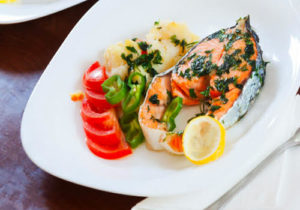
1) HEART HEALTHY FISH (OR PANEER) PIE
Nutritional value
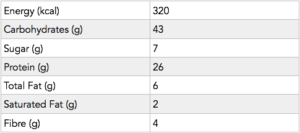
Ingredients
700 g potatoes peeled and diced
425 ml semi-skimmed fat milk
25 g low-fat spread
2 tablespoons fresh parsley chopped
100 g green peas
1 pinch ground black pepper
300 g sea-fish/basa/bhekti skinned and cut into chunks
(or 150 gm paneer chunks)
25 g reduced-fat mature Cheddar cheese grated
25 gm flour
Method
Preheat the oven to 200°C. Boil the potatoes for 15-20 minutes, drain and mash with 2 tablespoons of the milk. Put the remaining milk, put low fat spread and flour into a saucepan and bring it to boil. Over a medium heat, stirring continuously with wooden spoon until the sauce bubbles and thickens. Stir in the parsley, add the peas and season with pepper. Place the chunks of fish / paneer in an oven proof dish, pour the sauce over and then top with mashed potato. Sprinkle the cheese evenly over the surface. Bake in the centre of the oven for 25-30 minutes, until the top is golden brown. Serve with steamed or boiled broccoli. You can also do it the same on non stick pan and put the whole mixture inside microwave oven in convection and grill combination for 10/12 min.
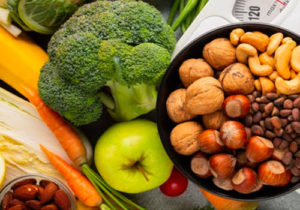
2) WINTER WARMER SALAD FOR THOSE SUFFERING FROM HIGH CHOLESTEROL
Nutritional value
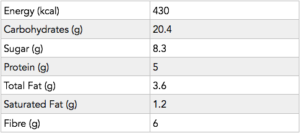
Ingredients
800g salad potatoes, sliced
2 tablespoons of mixed nuts
Ground black pepper
300g steamed long-steamed broccoli
1 small red onion, peeled and sliced
1tbsp olive oil /sunflower oil
Method
Place potatoes, broccoli and onion in a convection tray, drizzle with oil and Do it a convection only mode on microwave n put the ingredients until cooked.
Five minutes before cooking complete, add mixed nuts
Serve immediately.
(Serves – 2)
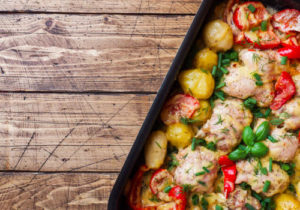
3) BAKED CHICKEN AND POTATO MEDITERRANEAN FOR DIABETES
Nutritional value
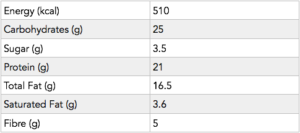
Ingredients
400 g chicken breast,
350 gm diced/ tofu
430 g paneer
800 g new potatoes, thickly sliced
1 yellow pepper, sliced
1 red pepper, sliced
2 teaspoons red pesto sauce (optional)
50g walnuts, chopped
200 ml low fat milk
80 g grated low fat cheddar
1tbsp olive oil/ 1 tbsp sunflower oil
1 tbsp cornflour
Method
Preheat oven/ microwave convection. Place potatoes, chopped vegetables, chicken/ tofu/ paneer and walnuts into a casserole dish. Mix milk, cornflour and cheese together and pour it over the veggies and chicken. Convection/ bake for 20 minutes. Remove and add pesto. Bake for a further 5 to 10 minutes and serve.
(Serves- 4 )
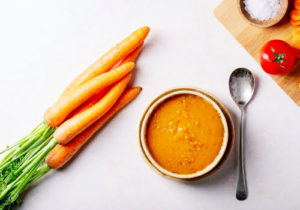
4) CARROT SOUP FOR WEIGHT-LOSS AND BELLY-FAT REDUCTION
Nutritional value
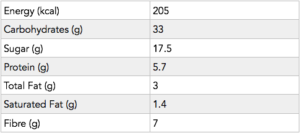
Ingredients
1 large onion chopped
8 carrots (or 500g), chopped
1.2 litres reduced salt vegetable/chicken stock
100g lower fat soft grated paneer
1 pinch ground black pepper
Method
Place onion, carrots and stock into a large saucepan.
Bring to the boil, then simmer for 20-25 minutes; partially covered. Blend the soup to a puree using a hand blender or food processor. Add grated paneer. Reheat and serve with a slice of wholegrain/multigrain bread- 1 slice.
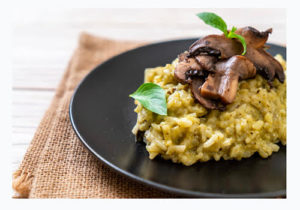
5) MUSHROOM BROWN RICE RISOTTO THAT IS ANTI-AGEING, ANTI-CANCER, HEART-HEALTHY, WEIGHT-REDUCING AND CHOLESTEROL LOWERING
Nutritional values
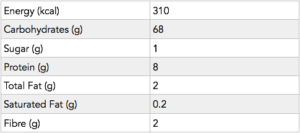
Ingredients
1 teaspoon olive oil
5 spring onions trimmed & chopped
300g risotto rice
1 garlic clove crushed
3 handfuls mushrooms sliced
900ml reduced salt vegetable or chicken stock
75g peas
1 pinch ground black pepper
Method
Heat the oil in a large saucepan and cook the spring onions over a medium-high heat for a few seconds. Add the rice and fry over a low heat for about 1 minute, stirring all the time, until it looks glossy but not brown. Add the garlic and mushrooms, then pour in about half the hot stock and stir well. Cook over a medium heat for 20-25 minutes, stirring often and slowly adding the remaining stock a little at a time, until the rice has soaked up all the liquid. Check that the rice is tender, it should have creamy texture. Add the peas, stirring gently to mix them in. Cook for another 1-2 minutes. Season and serve.
For sustainable and optimum weight-loss (read fat-loss) healthy lifestyle should be our priority. This includes eating right to be the key priority, along with being physically active. Talking about diet, which we know is the integral part in achieving overall healthy lifestyle, the battle can get confusing when you go searching the Internet for the “best diet.” There are so many diet patterns that trend on social media, that it well and truly baffles us. Plus, these diets work differently for every individual. Hence, it gets really very tricky to circle out the one diet that suits you and then follow it. So, here let us talk about some of the most popular diets trending this year.
1.Detox diet: As the name suggests, it flushes toxins out of your system. Some focus on fasting or just on drinking liquids. Others allow some foods, say fruits and vegetables. They typically are short diets—and not a way of eating you can stick to in the long run. It is best to take these up after festive seasons and special occasions, where binge-eating on unhealthy foods is common.
2.Intermittent fasting: The state of the science on intermittent fasting has evolved to the point that it can now be considered as one approach, with exercise and healthy food, to improving and maintaining health as a lifestyle approach. There are two main ways to adopt intermittent fasting into your life:
•Daily time-restricted feeding gives you a narrow window during which you can eat, usually 6 to 8 hours each day. This includes 14/16/18 hrs fasting with 10/8/6 hrs eating duration. Provided healthy eating and portion control to be done.
•5:2 intermittent fasting requires that people only eat one moderate-sized meal on two days each week.
3. Keto diet- Keto diet is a low carb, high fat and moderate protein diet. Lowering the body’s carb intake induces the body into what is called a ketosis. This state leads to the production of ketones through the liver’s breakdown of fat and hence the body starts burning ketones a source of fat as its primary source of energy. Some of the benefits of optimal ketone levels include- weight loss, enhanced mental and physical performance and good blood sugar control, hormone imbalances.
4. Metabolic diet-The diet focuses on the way your body metabolizes its food, as those with a faster metabolism are likely to burn more fat. The more constraint is given on timing and frequent eating of healthy food option, that helps in increasing your metabolism.
5. Paleo diet – it’s basically a high-protein, high-fiber eating plan that promises you can lose weight without cutting calories. Diet includes fresh lean meats and fish, fruits, and vegetables, and healthier fats, but can’t eat any processed foods, and diary on this diet.
6. Vegan diet- The basic philosophy related to vegan diet is based on two schools of nutritional (as well as ethical and environmental) thought to support a plant-based diet that eliminates many or all animal products. If we consider the simplest definition of vegetarianism is a diet, free of all food sources from animals meat, fish, and fowl flesh. But eating habits of vegetarians vary from person to person some are lacto-ovo vegetarians, who avoid animal flesh but eat eggs and milk products or some do avoid eggs also. On the other hand vegan is a class in which all the animal based products including honey, dairy products, eggs, non veg are avoided. Vegan diet are those who depends mainly on raw fruits, vegetables, legumes, sprouts, and nuts. People are more into habit of consuming plant based proteins like soya bean, pulses, whole grain flour, ragi/bajra flour or all types of millets. Even almond, oats or soya milk are being consumed instead of cow milk.
7. Gm diet-The diet plan was introduced around 1985 by General Motors for its employees. This diet limits your weekly food intake and focuses on eating fresh fruits and vegetables, healthy brown rice and for non-vegetarians, boiled chicken. It also emphasises on the consumption of complex carbohydrates, low-calorie vegetables and increased intake of water. This goes on per day basis limiting to 1 food group only. Like for example for 1st day only fruits, 2nd day- only vegetables, 3rd day- fruits and vegetables except for banana, 4th day- only bananas and milk, 5th -6th day – dal-rice and cheese, 7th day- complete meal etc.
8. Mediterranean diet- one of the easiest diet to follow is Mediterranean diet plan, the best at preventing diabetes, and the best plant-based diet. But in general, you’d be eating lots of fruits and vegetables, beans and nuts, healthy grains, fish, olive oil, small amounts of meat and dairy and red wine. Along with good amount of workout/daily exercise. Basically the focus is laid on healthy eating with good portion control and timely eating.
Latest News Listings
Crafted by Webcreatore Digital Solutions LLP.





